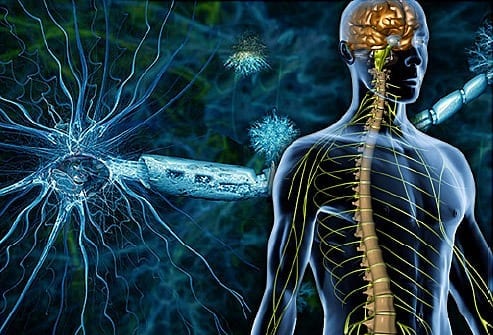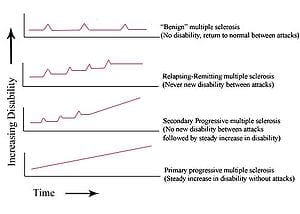
Stem cells are starting to prove their value as medical treatments
THIRTY years ago a young haematologist called Richard Burt was training at Johns Hopkins University, in Baltimore. He noticed that after leukaemia patients had received a treatment to wipe out their immune systems, they needed to be re-immunised against diseases such as measles and mumps. Although the patients in question had been vaccinated as children, the therapy for their blood cancer had erased this cellular memory. Dr Burt turned to his teacher, William Burns, and ask whether the same might be possible in autoimmune diseases. “I could see a light go on in his eyes. ‘You should try it in multiple sclerosis’ he said.” Thus began decades of painstaking work.
Multiple sclerosis (MS) happens when the body’s immune system learns to attack its own nerve fibres in the same way that it learns to attack invading pathogens. Nobody really understands what causes this misplaced learning. But Dr Burt’s idea did not depend on knowing that. He just wanted to wipe the memory out, in the way that the memory of a vaccination is wiped out by chemotherapy. By 2009 Dr Burt, now at Northwestern University, in Chicago, had proved that his treatment worked in patients with the most common form of the disease, relapsing remitting MS. The treatment involves using lower-dose chemotherapy to kill the white blood cells that are responsible for attacking nerve fibres, and then rebooting the immune system using stem cells collected from the patient before treatment began.
Stem cells are the source from which more specialised cells develop. Those found in bone marrow, known as hematopoietic stem cells, produce the many different cells found in blood, including the white cells implicated in MS. In Dr Burt’s therapy such stem cells are extracted from a patient, stored until after the chemotherapy, and then infused back into him. Ten days later, he can go home.
It is effective. Although there is a relapse rate of around 10% within five years, many who have been treated in randomised trials in Brazil, Britain and Sweden feel as though they have been cured. Proving they actually have been means waiting for the results of the trials, and watching how participants fare over many years. Already patients have been seen to improve for two years after treatment.
This work should give drug companies some pause for thought.
Read more: Curing multiple sclerosis
The Latest on: Curing multiple sclerosis
[google_news title=”” keyword=”Curing multiple sclerosis” num_posts=”10″ blurb_length=”0″ show_thumb=”left”]
via Google News
The Latest on: Curing multiple sclerosis
- Pedaling towards a cure: Thousands converge at Kyle Field for Bike MS 150on April 28, 2024 at 10:49 pm
Thousands of cyclists from across the Lone Star State made their way to Kyle Field this weekend for the Bike MS 150 ride, the nation’s largest fundraiser for multiple sclerosis.
- Hundreds walk in De Pere to raise awareness for Multiple Sclerosison April 28, 2024 at 9:47 am
Hundreds gathered at West De Pere High School to raise awareness for those who have been diagnosed with Multiple Sclerosis. Whether they were supporting a family member or friends, everyone who walked ...
- ‘You wouldn’t know I had it,’ woman living with Multiple Sclerosis holding awareness walkon April 26, 2024 at 6:44 pm
Happening at 9 a.m. on April 27, a walk to raise funds for the National Multiple Sclerosis Society is happening at Capaha Park ...
- Top 10 Needs of People With Multiple Sclerosis and Their Significant Otherson April 26, 2024 at 5:00 pm
The purpose of this study was to identify the needs of patients with multiple sclerosis (MS) and their significant others. A quantitative questionnaire, developed from focus groups and consisting ...
- Walking to end Multiple Sclerosison April 21, 2024 at 5:50 pm
Hundreds of people walked to find a cure for multiple sclerosis while raising tens of thousands of dollars. It’s meant to bring awareness and raise money for the ...
- Upcoming fundraising events spread awareness, raise money for multiple sclerosis cureon April 16, 2024 at 12:03 pm
Right now, there is no cure for multiple sclerosis, but some upcoming fundraising events are hoping to change that.
- Austin bike ride set to raise money for multiple sclerosison April 15, 2024 at 7:59 am
AUSTIN (KXAN) — An estimated 6,500 bike riders will hit the streets in Texas on Saturday, April 27th as part of an effort to raise money for a cure for multiple sclerosis. The 150-mile ride from ...
- Walk MS: Walk MS San Diego Set to Raise Awareness and Find a Cure, with more than 1,500 people expected to participate!on April 12, 2024 at 4:41 pm
On April 20th friends, families and co-workers will meet at Walk MS: San Diego to raise awareness and funds to find a cure for multiple sclerosis. Hosted by the National Multiple Sclerosis Society, ...
- Spokane moms with multiple sclerosis aim for a cure and step forward in hopeon April 11, 2024 at 5:00 pm
to support those battling Multiple Sclerosis (MS). Currently, there is no cure, but there are medications that can slow the disease, according to multiple online sources. No two people suffer with ...
- SEEN: Together for a Cure Multiple Sclerosis Luncheonon April 6, 2024 at 8:08 pm
Were you Seen at the Together for a Cure Multiple Sclerosis Luncheon, Honoring Frank Adams Jewelers President Kimberly Adams Russell with the Fighting Spirit of Cindy Martin Award on April 4 ...
via Bing News









